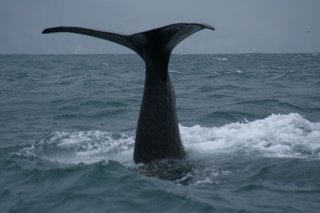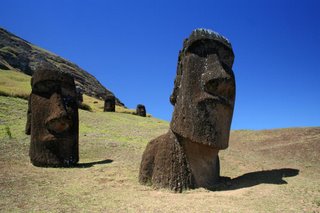Travels in Kiwiland

We got a flight from Santiago to Auckland, skipping out the 14th March altogether as we passed over the international dateline. The short film we were shown on arrival in New Zealand was quite amusing. Complete with the sound of a prison door slamming shut, it made it clear that a tourist trying to smuggle an apple into New Zealand would be treated in much the same way as an international terrorist or a drug smuggler in other countries. Forewarned, we handed our tent in for inspection, just in case any foreign mud was accidentally sticking to it.
Initially, we were both quite disoriented in Auckland due to our lack of sleep and it seeming strangely like England but not like England at the same time.
After a good night's sleep we headed straight off to Matamata to look at the place where Hobbiton was filmed for the Lord of the Rings trilogy. Most of the original set had been removed but you could still see some of the Hobbit holes and the tour took us on a pleasant walk around the area, which was very pretty. Though we didn't realise at the time, this was the only day so far in New Zealand where we would be lucky enough to see the sun shine!
After Matamata we took the bus to Rotaroa which is famous for its Maori culture and hot springs. Rotaroa is a pretty ugly looking place, if you thought of Milton Keynes smelling of rotten eggs (because of the sulphur) then you wouldn't have it far wrong. We dived straight into the pools at the Polynesian Spa and soaked in the hot water which was pretty good fun.
The next day we went to the Wai-O-Tapu thermal wonderland near Rotaroa. With its bubbling mud pools, geyser and weird colored pools it should have been spectacular. However somehow the hordes of other tourists, modern visitors centre, safety notices, fences and well marked paths seemed to detract from the experience. It was the complete opposite of our trip to the Bolivian Salt flats where tourists posed unsupervised for photos standing on the edge of boiling pools of water with geysers shooting up all around them!
Our next move was to Turangi, a little place with just a few houses and a gas station spread out around a roundabout. We were there to walk the Tongariro Crossing, an 18km trek across volcanic landscape that is supposed to be one of the most spectacular day walks in New Zealand. It was in this area of New Zealand that the scenes of Mordor were filmed in the Lord of the Rings trilogy.
We were dropped off at 8am in the morning at the start of the trek. Unfortunately so were about three hundred other walkers, making the track more like Oxford street on Christmas Eve than a walk in the wilderness. Initially we saw quite an interesting volcanic landscape with Mount Ngauruhoe (Mount Doom) on our right hand side. Unfortunately as we climbed higher into the cloud, we saw nothing whatsoever and walked past all the craters and other sights none the wiser.
The following day we got a bus to Wellington where we went to stay with Eleonora, Marco and their daughter Elena. Eleonora is the sister of a friend of ours from Italy, Giambattista, and she kindly offered to put us up. After a delicious Italian meal Steve quizzed Marco about his job, he works as a computer animator for the company that did the special effects for the Lord of the Rings and King Kong. As I know very little about graphics I probably only understood about 50% of what they were talking about but I was dead impressed by the large model figure of the King of the Ring Wraiths that Marco kept on a shelf!
The next day, after making that upsetting discovery that after spending five months talking Spanish I can no longer talk Italian properly, we headed into the centre of Wellington. It was raining so much that we ended up wearing waterproof trousers as well as rain coats. We went to the Te Papa museum which had very interesting exhibitions on the flora and fauna of New Zealand and its history, complete with a large Maori war canoe. Maybe it was the rain, but I didn't find the centre of Wellington very appealing. Apparently most of the historic centre was knocked down in the 1970s to make way for a shopping centre.
It was still raining the next day when we took a ferry to South Island. After a bit of a choppy crossing we arrived in Picton, where we took a water taxi to Hopewell hostel in the Malborough Sounds. A very nice holiday resort masquerading as a backpackers hostel, Hopewell hostel is set in a very beautiful and isolated location
in wooded fjords. We spent a couple of days relaxing at Hopewell, our room looked out across the bay and we could hear the waves lapping at night. Although the weather was pretty gloomy, we went sea kayaking along the coast which was fun and relaxed in the hot tub. We also ate lots of mussels, which the hostel provided free in large quantities to guests every other night.
From Hopewell we went back to Picton where we got a train to Kaikoura further down the coast. Kaikoura is famous for its marine life because of the currents that bring nutrients to the area. The continental shelf rapidly drops to over 800m off shore from Kaikoura, meaning that whales can be spotted not far out to sea.
We booked onto a whale watching trip which initially felt more like a whale hunt!
The captain was in radio contact with other boats looking for whales and also had a whale listening device. The boat would stop to listen for a whale for a while and then shoot off at great speed, in quite a stormy sea, towards its supposed location.
Eventually, we were rewarded with sightings of two sperm whales, one after another. Our boat stopped at a reasonable distance away from the first sperm whale and we were able to watch the large brown creature, lying like a strange sea monster, on the surface taking in air. After a few minutes he dived back down into the ocean flicking his tail into the air as he went.
Every one was then hurried back inside to see another sperm whale that had been spotted nearby. It was difficult to really get a proper idea of the scale of the whale from the surface (they are about 18m long and dive deeper than any other whale) but it was great to get an opportunity to see this magnificent creature in real life.
Sadly, while whales are protected in New Zealand waters a number of nations including Japan, Norway and Iceland continue to catch them in ever increasing numbers. Japan even goes into supposedly protected Antarctic waters where it catches endangered species of whale for allegedly scientific purposes. Perhaps not surprisingly most of these whales seem to some how end up on supermarket shelves.
While we have been enjoying our time in New Zealand, so far we haven't had much luck with the weather and the scenery for which New Zealand is so famous has been almost entirely obscured by low lying cloud. The people here are very friendly however. The tourist industry seems to be mainly run by cheerful and motherly middle aged women who do everything from driving mini buses to serving free extra portions to weary looking travellers at late opening fish and chip shops.
Next we are heading to Queenstown in the Fiordland National Park which is supposed to be one of the most beautiful areas of the country. Unfortunately for us the weather forecast is predicting showers and cloud for the week ahead...
